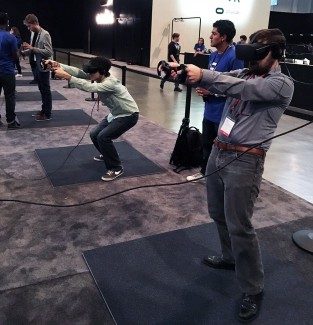Long a point of contention, Oculus last week announced a welcome new stance: the Rift will be officially supporting 360 degree tracking and room-scale as part of the forthcoming Touch launch.
At the company’s ‘Connect’ developer conference it was finally revealed that Oculus now plans to support four Rift and Touch camera configurations:
- One camera in front: seated/standing gamepad experiences
- Two cameras in front: standing front-facing Touch experiences
- Two cameras opposite: standing 360 degree Touch experiences
- Three cameras in triangle layout: ‘room-scale’ Touch experience
Prior to the announcement last week, Oculus had only officially committed to the first two configurations. Though they will officially support these other setups, Oculus says they believe the front-facing setup is the most practical and will be used by the majority of users. Questions remain as to what amount of fragmentation these varying configurations might cause among the Rift userbase.
As the Touch launch approaches in December, support for four tracking cameras has already been baked into the Oculus Home platform (though the company’s recent announcements only made mention of configurations utilizing three cameras). While the $200 Touch price tag will include one additional tracking camera, that leaves users with just two (the first being included with the Rift); Oculus plans to sell individual cameras for $80 to achieve the three-camera room-scale setup.


Room-scale is, quite literally, a big deal. Much can be accomplished constrained to chairs and Oculus’ prolific demo mats, but VR frequently compels us to stand up, inspect details up close, flail our weapons in all directions, and duck & dodge in ways that demand a big space—something HTC’s Vive has been doing since its launch earlier this year. Officially unlocking these experiences on the Rift will make Home all the richer.
With the release of Touch on December 6th, the Rift platform will have three recommended setups. The fundamental reason for this is occlusion, the possibility that some crucial portion of the tracking markers on the Rift and Touch might be blocked from the camera’s view. Modern VR headsets use highly calibrated IMUs which are capable of determining an object’s rotations accurately at very low latencies, but which rapidly drift out of alignment when used to further judge the object’s movement through space. Both Rift and Touch use infrared LED markers to serve as a corrective frame of reference for positional tracking, but can’t do this when too many of these markers are blocked from view.
Introducing two Touch controllers complicates matters considerably further. Now a player can turn 180° from the camera, hold the controllers near their chest, and the controllers become completely occluded from the camera, eliminating their ability to be tracked through space. When it comes to Oculus’ tracking system, there’s only one solution to the occlusion problem: more cameras.
Two cameras placed in opposite corners of the room will provide a large playspace, but this risks placing them so far away from the headset that they have trouble seeing the markers clearly; this is ‘room-scale’ capable and a full 360° degree experience, but not terribly robust, according to Oculus.
With a third camera, robust room-scale interactions in full 360° become possible, Oculus says. Though it may have greater requirements for setup, room-scale tracking can significantly enhance immersion. Owlchemy CTO Devin Reimer has said, about the HTC Vive, that the addition of room-scale to a VR experience can “almost get [Presence] for free”, thanks to the added immersion that comes with being able to physically explore the space around you in a significant way.
Oculus’ newfound support for more tracking configurations means that a whole host of previously problematic content (designed for Vive’s room-scale capability) may find itself welcome both on Home and on the hard drives of VR enthusiasts everywhere.

